A Bit of Purple Heaven
Ingredients:
5 stems dark purple lilacs (Syringa vulgaris), grown by Sunshine Crafts and Flowers

Ingredients:
5 stems dark purple lilacs (Syringa vulgaris), grown by Sunshine Crafts and Flowers
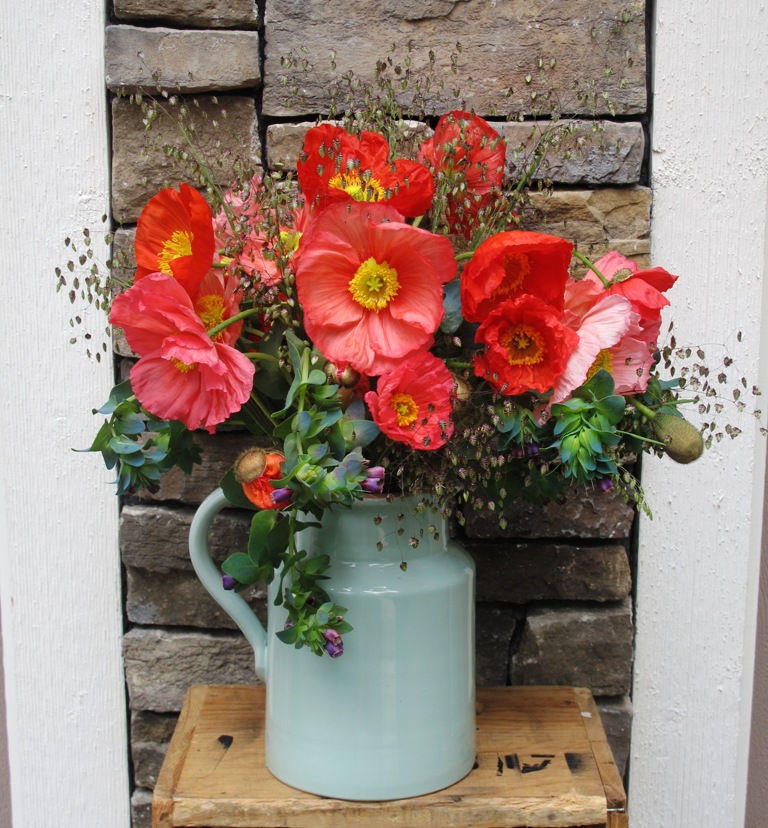
Why do we love poppies so much? Perhaps it’s because of their pure, vibrant petal colors with the charming button-like centers.
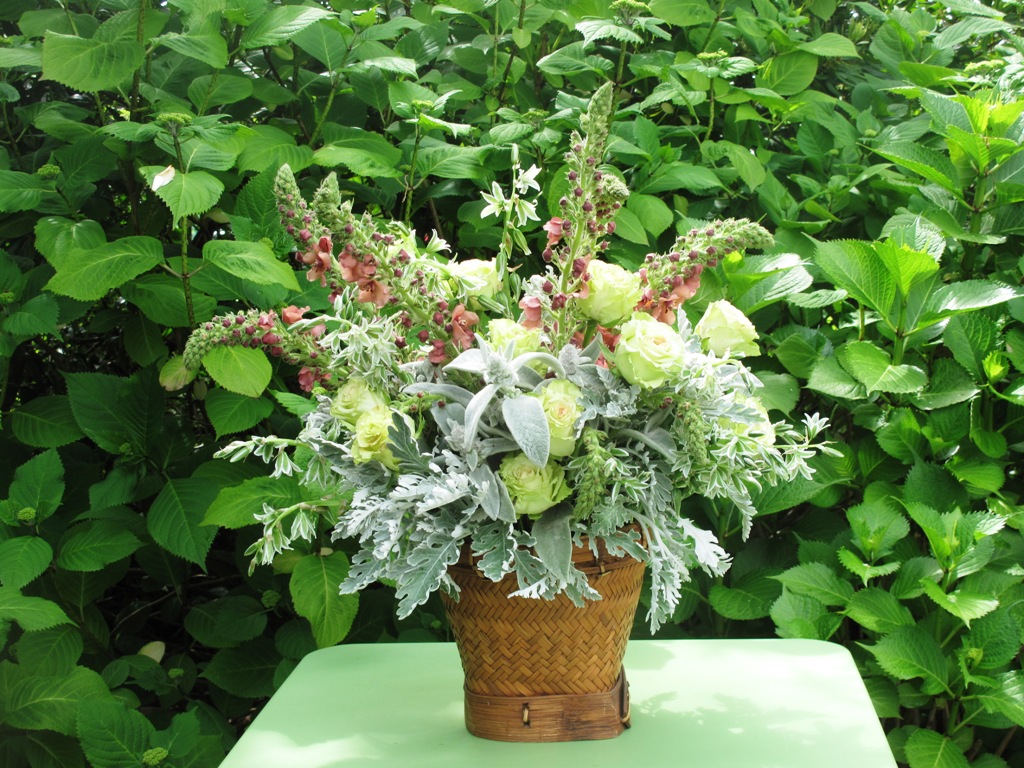
An unexpected combination, inspired by the pale ‘Supergreen’ hybrid tea roses given to me by the grower
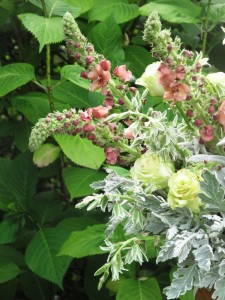
This sweet detail shows the delicate features of the apricot verbascum and the varietgated Star of Bethlehem
Ingredients:
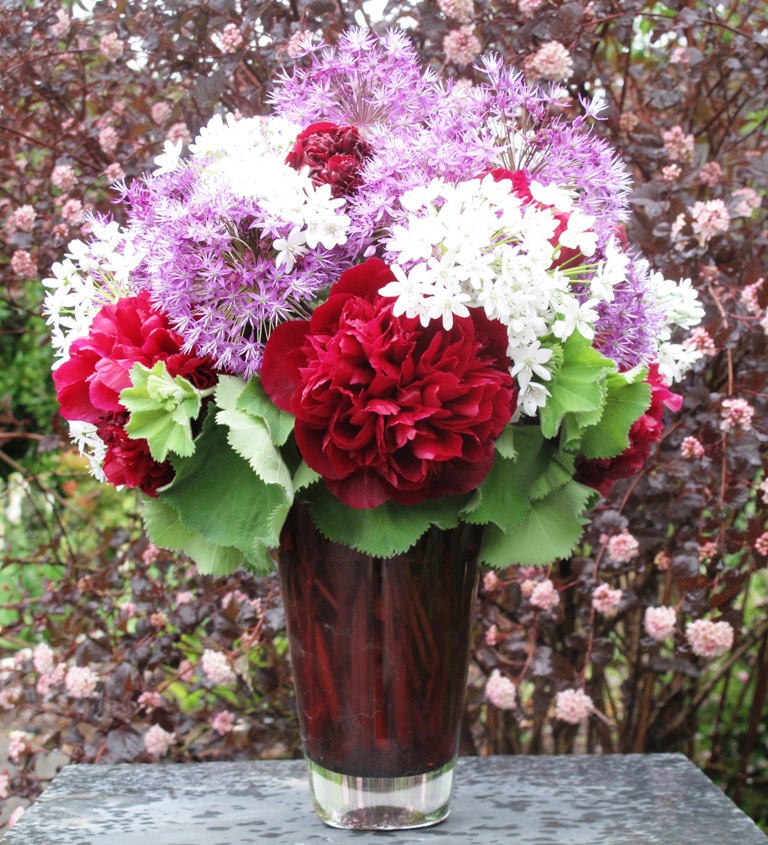
These luscious red peonies from a local grower reflect the garnet-colored art glass and complement two forms of ornamental allium.
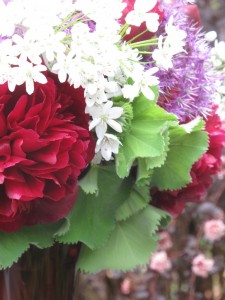
The lady’s mantle foliage is absolutely the BEST for spring bouquets. And if your garden is like mine, it’s super abundant right now!
Ingredients:
10 stems red peonies, grown by Ojeda Farms
7 stems each ‘Purple Sensation’ and ‘Cowanii’ ornamental alliums, grown by Choice Bulb Farms
12 stems lady’s mantle foliage (Alchemilla mollis), harvested from my garden
Vase:
9-inch tall x 5-inch diameter hand-blown glass vase
Design 101
Create a collar: You can use flowers or foliage to ring the base of a bouquet or arrangement as a finishing detail. This technique is usually done as the bouquet’s last step. For this arrangement, I pre-cut the greenery and then added it beneath the peonies, slightly overlapping each stem as I worked around the circumference of the bouquet. Here, the lady’s mantle visually separates the dark red peonies from the wine-red vase.
Lots of news to share, including this very timely interview that Seattle’s NPR station KPLU-FM aired today. Environment reporter Bellamy Pailthorp contacted me to discuss “sustainable flowers for Mother’s Day,” and thanks to her incredible interviewing and editing talents, a 25-minute conversation turned into a 4-1/2 minute segment. You can listen to it here.
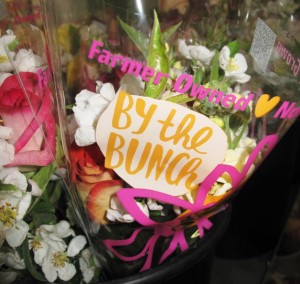
Remember this cool logo: By the Bunch. It means these gorgeous bouquets are possible because their ingredients were grown by a bunch of awesome NW flower farmers
The interview gave me a chance to talk about the excitement at the Seattle Wholesale Growers Market – a just-launched supermarket bouquet program called “By the Bunch.” The beauty of this program is that it produces a sizeable income stream for every farmer-member at the SWGM Cooperative. Together they are so much more than the sum of their parts (or their flower fields, for that matter).
Today, the Thursday before Mother’s Day, was perhaps the most insane work day ever experienced by the Bouquet team, including managers Kristen Parris and Nicole Cordier, along with their new design team members, Carly and Michelle.
But in order to produce a staggering number of bouquets today – something like 700 bunches – flower farmers Diane Szukovathy and Vivian Larson had to show up and volunteer their time as bouquet-makers. I stopped by at around 9:30 a.m. to catch the activity.
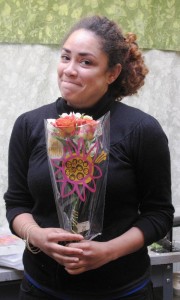
SWGMC Front-Desk Manager, talented designer and inspiring leader for the local flower movement, Nicole Cordier.
Oh, bouquet-making sounds so romantic, doesn’t it? But by 7 p.m., when I had to bring by supplies for a special event tomorrow morning, Kristen and Nicole were still there, finishing up the final 100 bunches. Ever-positive, but clearly exhausted, these women believe so much in getting sustainable and locally-grown blooms into the hands of Seattle area consumers that they are willing to go without food and breaks just to achieve the goal. As I told them: If you can get through Mother’s Day, you can do anything. (They probably didn’t need to hear it from me!)
Read more about the By the Bunch program here. The brand development, graphic design and packaging is supported by a USDA Multi-State Specialty Crop Block Grant through the Washington State Department of Agriculture and the Oregon Department of Agriculture.
My photos from today’s visit will wow you. If you haven’t figured out what to give Mom for her special day on Sunday, May 12th, stop by these outlets for LOCAL, SEASONAL Bouquets – straight from Northwest fields: PCC Natural Markets, Town & Country Markets and Madison Market.
My camera snatched some of today’s delicious springtime beauty to share:
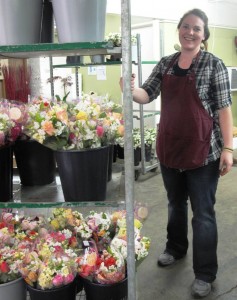
At 9:30 a.m. today, Michelle was ready to wheel an entire cart of bunches into the cooler. So exciting to have her on the SWGMC team!
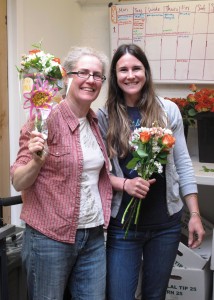
A moment to smile, and who wouldn’t? Creating bouquets for Mother’s Day is a special job – and Diane Szukovathy of Jello Mold Farm (and SWGMC president) was on hand to help designer Carly and the rest of the team this morning.
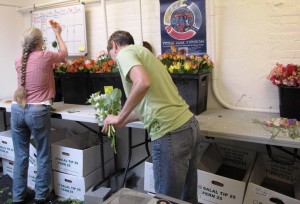
Two of the founding farmers of SWGMC, Diane Szukovathy and Vivian Larson, spent the morning making bouquets with the team.
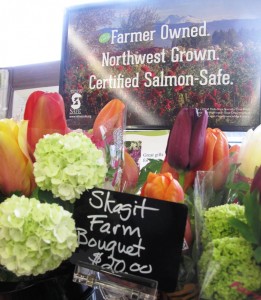
Later this morning I stopped by my local PCC Natural Market to see the By the Bunch floral display. Gotta love this messaging~
For every mother out there, HAPPY MOTHER’S DAY ~ and may you enjoy your garden, your flowers and your families.
Here’s what I’ve been up to lately. I traveled to Southern California all of last week – from Saturday, April 13th through Saturday, April 20th. I experienced many great highlights; too many to mention. Here are some of them:
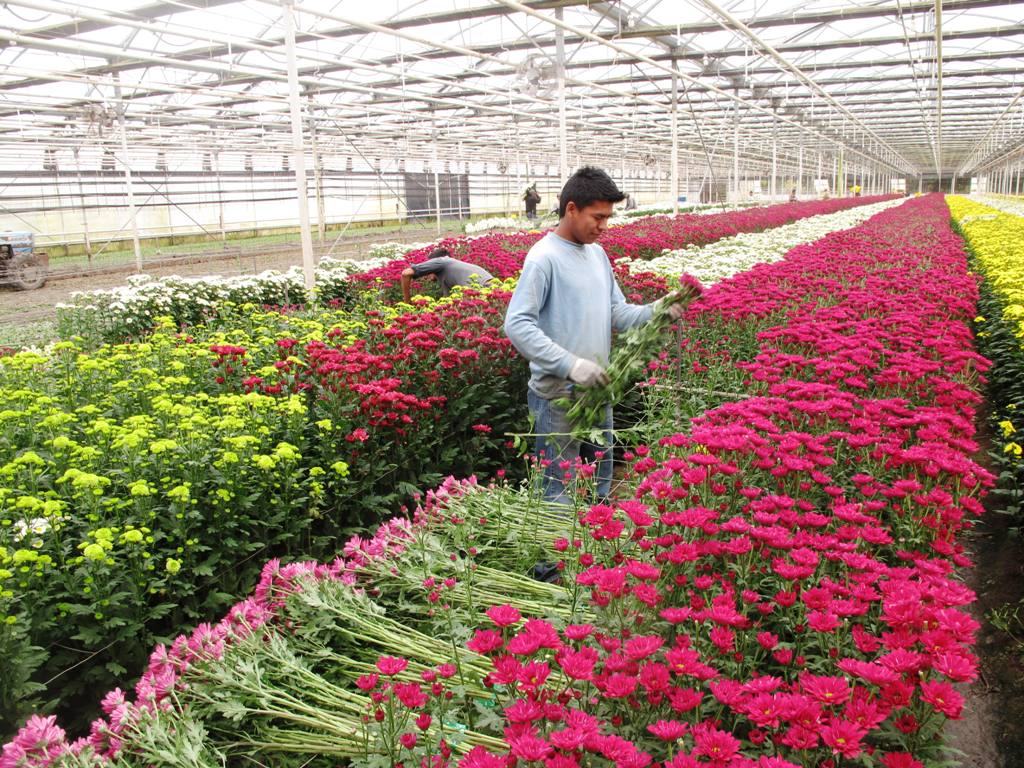
Tours focused on the entire process – from planting and growing to harvesting and grading. Mums, also known as pom poms, are one of the last commercially grown flowers still grown in soil.
DAY One: Carpinteria Greenhouse & Nursery Tour, sponsored by the California Cut Flower Commission. I was hosted by Harry and Michele Van Wingerden, the great folks at Myriad Roses and Padaro Floral Design for a day of book-signings and eco-floral demonstrations. A special thanks to the Van Wingerden family, CCFC CEO/Ambassador Kasey Cronquist and Event Planner Anna Kalins for making it a successful and enjoyable day!
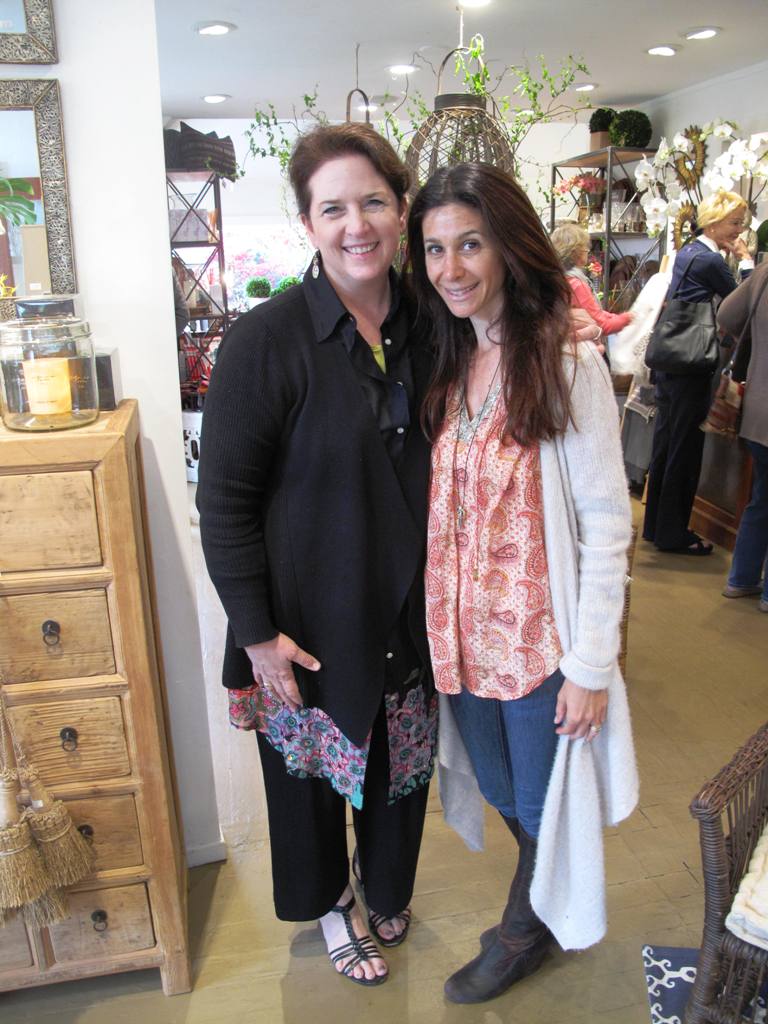
Erin Taylor, designer of flowers, interiors, landscapes and more~ The talented owner of botanik in Summerland, California hosted my lovely book event.
DAY Two: Book signing and flower demos at botanik in Summerland. Loved spending time with very talented owner Erin Taylor and her team. After several hours at botanik, I met up with Cristi Walden and we headed to Sea Crest Nursery, her father Jack Stevenson’s palm and cycad collection. It was so exciting to return to this beautiful place and hear how my talented friend is learning the business of growing and selling amazing landscaping plants (oh, and propagating, too!).
READ MORE…
Ingredients:
10 stems purple lilacs (Syringa vulgaris), grown by Oregon Coastal Flowers
10 stems garden hellebores (Helleborus orientalis), grown by Jello Mold Farm
10 stems Fritillaria assyriaca, a spring-flowering bulb, grown by Choice Bulb Farms
Vase:
17-inch tall x 7-inch diameter cream urn
From the Farmer
Hellebore how-to: Anyone who grows hellebores in their garden knows how frustrating it is to cut a few blooms and bring them inside, only to watch them wilt in a vase of water. Now I enjoy success when I use hellebores in my bouquets, thanks to an important lesson shared by Diane Szukovathy, co-owner of Jello Mold Farm. “Harvest hellebores after they have matured past the flower stage and the seed pods are beginning to form,” she advises. “By then, the petals have started to leather up and those hellebores will be rock solid in an arrangement for ten days.”
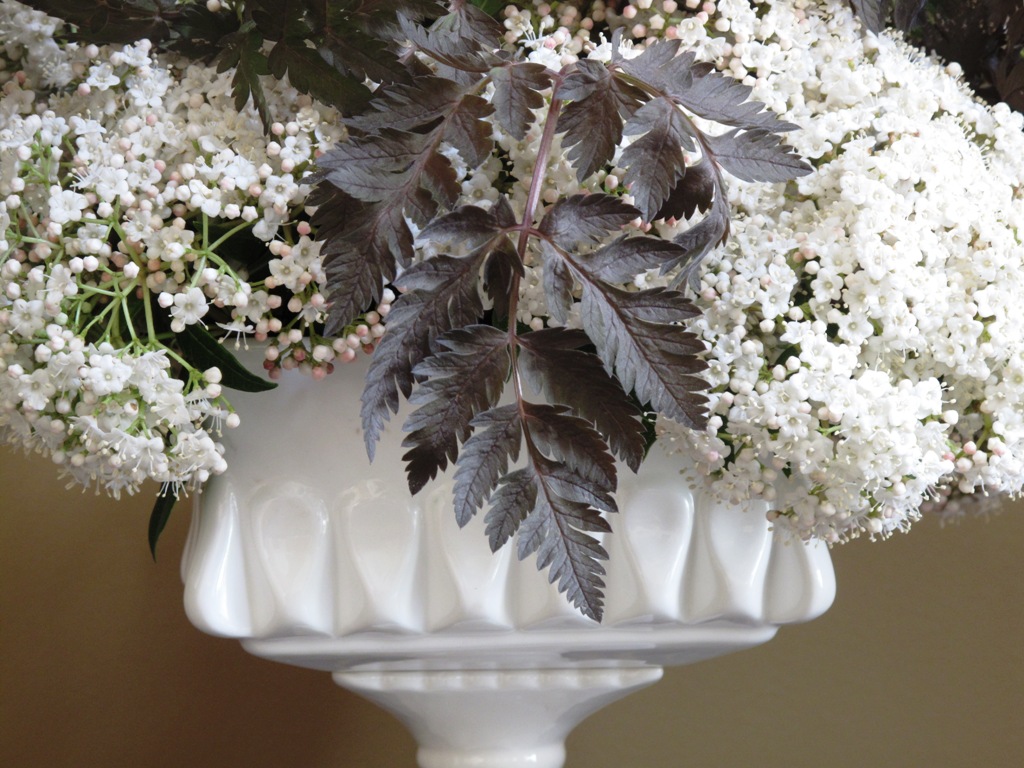
A graphic, fresh combination: dark-chocolate-colored Anthriscus sylvestris foliage with creamy white Viburnum tinus flowers.
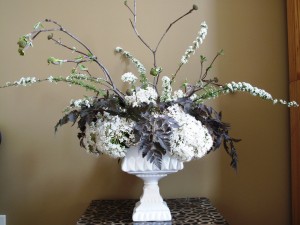
The white square dish, elevated on a pedestal, makes this simple grouping of flowers all the more special.
Ingredients:
8-11 Viburnum tinus blooms, harvested from Charlotte Behnke’s Seattle garden
6 stems Anthriscus sylvestris ‘Ravenswing’, grown by Jello Mold Farm
6 stems bridal wreath spirea (Spiraea cantoniensis ‘Flore Pleno’), grown by Charles Little & Co.
3 stems green dogwood (Cornus sp.), harvested by Oregon Coastal Flowers
Vase:
6-inch square x 3-inch deep white ceramic nut dish (overall height is 8 inches)
NOTE: Each Sunday of this year, I post my photographs, a how-to “recipe” and tip for that week’s floral arrangement, created for my new book, Slow Flowers.
Enjoy the floral journey through 52 weeks of the year~
With the arrival of spring here in Seattle, we flower lovers have lots to celebrate! That’s because the wistful beauty coming from our local flower fields, meadows and farms are simply sublime.
When I stepped inside the Seattle Wholesale Growers Market two days ago, I was stopped in my tracks. The botanical abundance in each stall made me catch my breath with happiness~ A new season is upon us – hurrah!!!
I brought home arm-loads of goodies, enough to make three lovely arrangements of three different sizes. The common threads are these blooms, including some clipped from my own garden. and the style of vase. I cannot resist a footed urn!
As noted above, my vase(s) of choice are footed urns or bowls. All three used here are vintage and quite dear to me.
I hope that seeing how I used them inspires you to snatch up a footed vase or bowl, an urn or anything with a pedestal base – they are indeed the superior vessels for showcasing flowers. If you frequent vintage sites online, flea markets or garage sales . . . maybe you’ll be just as lucky as I have been. I’ve used vintage metal flower frogs inside each. The frogs are like half-dome cages and because they are metal, they’re heavy enough to just sink to the bottom of the vessel (no tape or stickum required).
Constance Spry wrote about one of her favorite vases — a footed marble bowl — in her 1933 book Flower Decoration. I can only imagine how pricey one of these vases would be today! Here’s what she had to say:
“This vase is beautiful to look at whether empty or filled with flowers. It is so heavy that it is not disturbed by the heaviest branches of fruit or blossom, and its soft, pale-brown colour enhances whatever one chooses to put in it.”
Here are the designs that gave me so much pleasure:
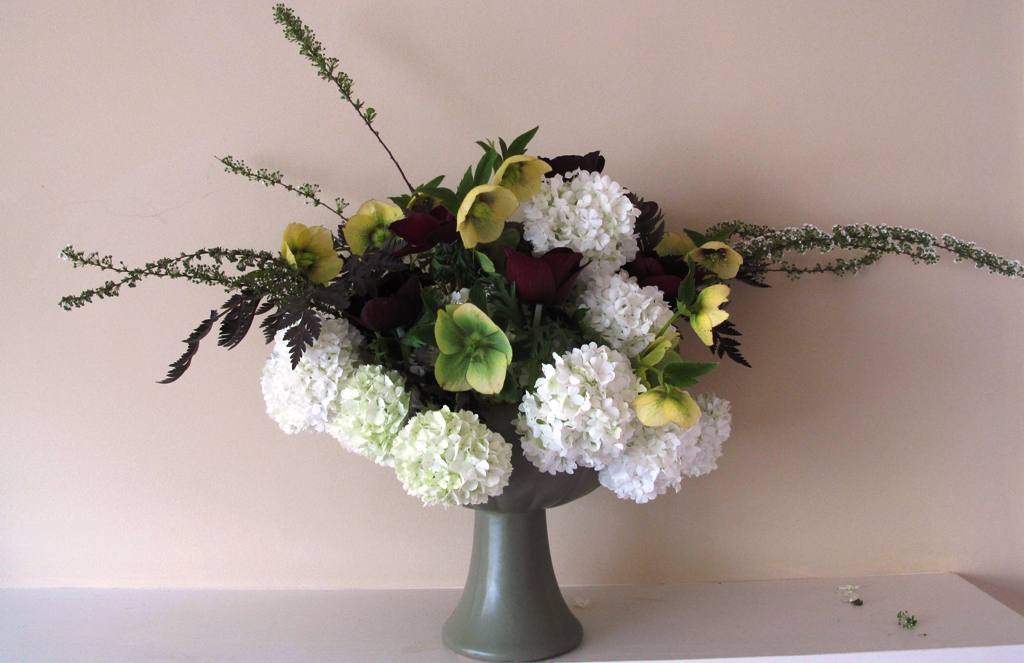
A Green Floraline Pedestal Bowl, featuring snowball viburnum, hellebores, anemones, Anthriscus foliage and bridal wreath spirea.
After I created and photographed this arrangement, I decided to see how it looked WITHOUT those spikey branches. So here’s version 2 of the same bouquet:
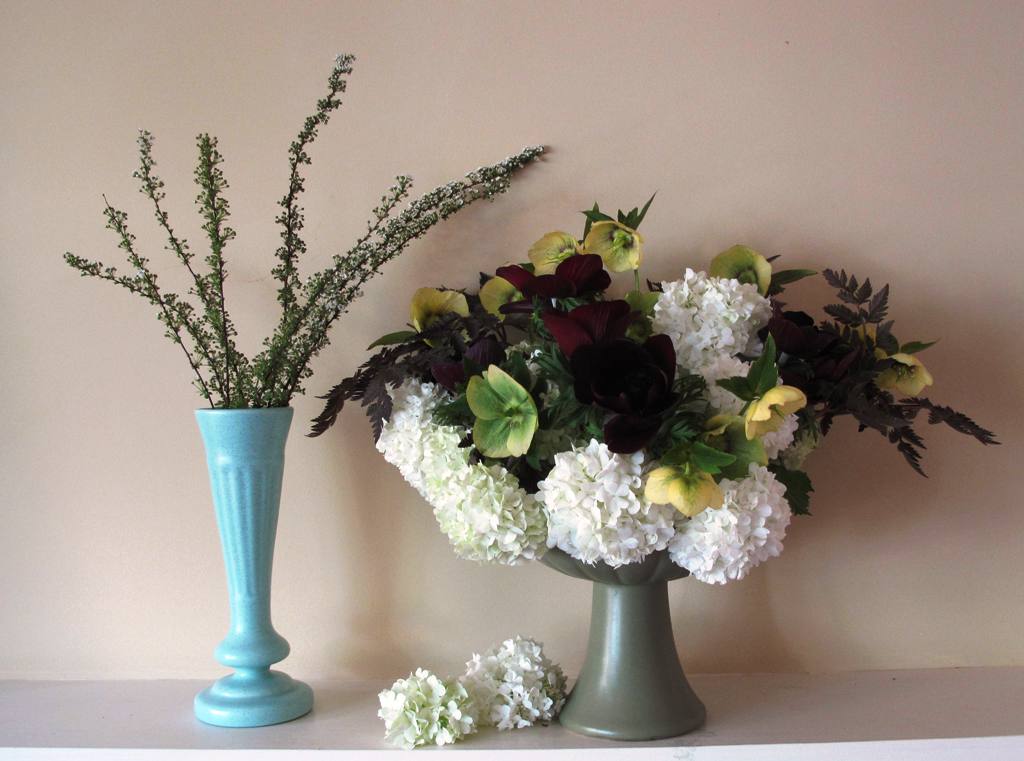
The spirea moved into the teal blue Haegar (vintage) bud vase, while the green Floraline footed bowl contains the remaining blooms.
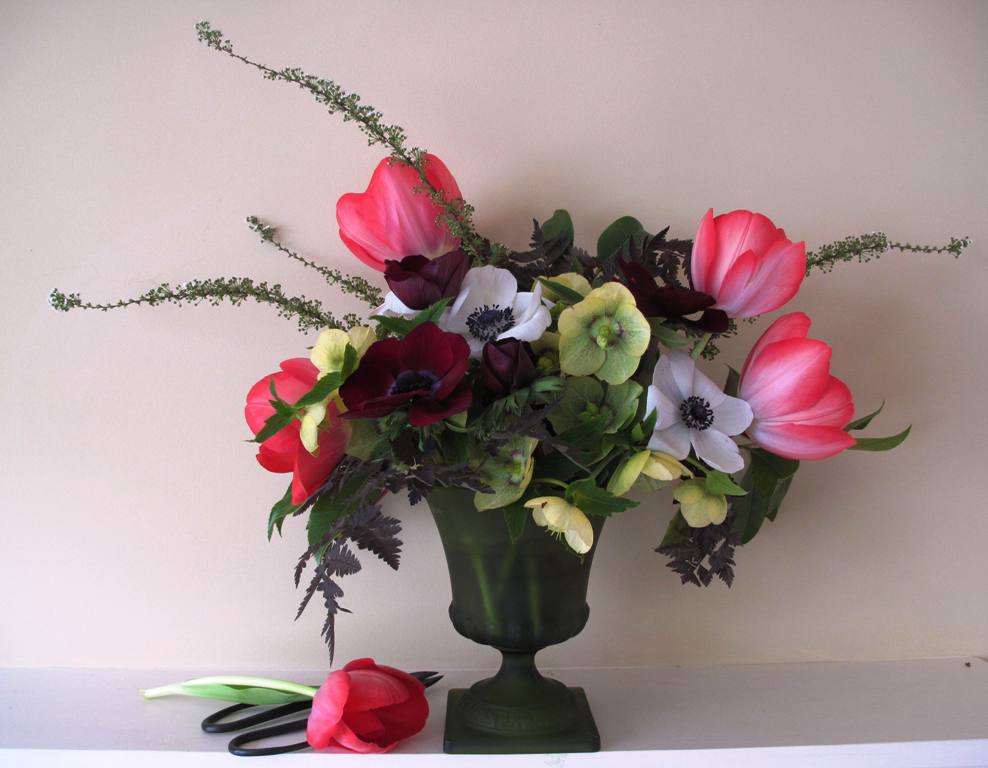
With hellebores, white and burgundy anemones, salmon pink tulips, Anthriscus foliage, camellia foliage and bridal wreath spirea.
Ingredients:
Kerria japonica ‘Variegata’, which has white-edge leaves
Flowering quince (Chaenomeles x superba), available in coral, red, pink or white
Vase:
17-inch tall x 7-inch diameter cream urn. This is my go-to vase for last-minute arrangements and it is tall enough to handle the branches, which are nearly three feet long.
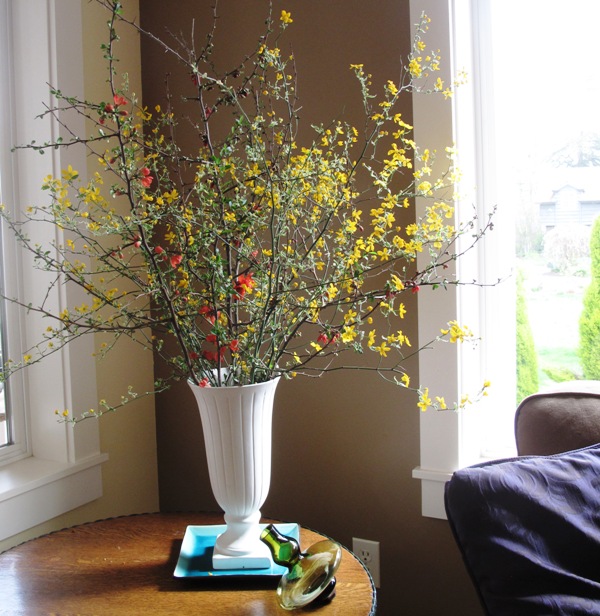
If you add cut branches to the vase when the flowers haven’t yet opened, the warmth of your home will coax them into flowering indoors. . . for up to two weeks.
From the Farmer
Jump-start spring: Many flowering shrubs and trees are suitable for indoor forcing. In addition to Kerria and quince, you can cut the bare branches of forsythia, witch hazel and numerous fruit trees. Harvest branches when their buds begin to swell, taking care to use proper pruning techniques. Re-cut the stems on a 45-degree angle and place them in a vase of clean water. Over time, the buds will respond to your home’s warmer temperature and begin to flower. Be sure to change the water as you would with any floral arrangement.
NOTE: Each Sunday of this year, I will post my photographs, “recipe” and tip for that week’s floral arrangement, created for my new book, Slow Flowers.
Enjoy the floral journey through 52 weeks of the year~
© Debra Prinzing, all written and photographic content. Website design/development by Willo Bellwood/Metric Media